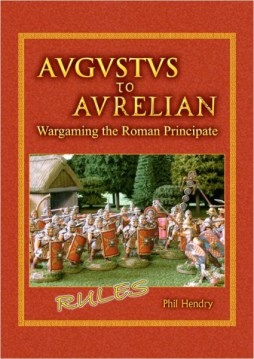
Avgvstvs to Avrelian
AVGVSTVS to AVRELIAN is a set of miniature wargames rules written and published by Phil Hendry designed with the express purpose of recreating battles of the Roman Principate – the era between the end of the Republic, and the accession of Diocletian and the Tetrarchy; the era most people think of when they’re thinking about the Roman Empire. It’s an era, firstly, of expansion, then of stability, and then of descent into chaos, and finally, of a partial recovery. During this era, the Roman army was organised, and fought, in more or less the same manner, so it makes sense to write a set of rules covering just that period.
The main aim of the rules is to place the player in the sandals of the general. The mechanisms aim to limit the ‘helicopter general’ effect. The emphasis is not on the ‘micro-management’ of individual units. Rather, it is hoped that the player will take on the role of the ancient general, accept that he has limited control, and enjoy trying to make the most of what influence he has. The player’s role most of the time, rather like that of the ancient general, is one of reacting to events rather than controlling them. This may be a source of frustration if you’re used to having minute control over every aspect of the battle.
Ancient armies, partly by virtue of poor communications, had a lot of ‘inertia’ – once they were doing one thing, it was difficult to get them to change to do something different. There was also a lot of ‘friction’ in ancient battles. We hope that the sequence of play reflects this. There’s plenty of suspense – will the card you need come up this round or not – and what will you do if it doesn’t? This reliance on cards is intended to model the ‘unusual’ things that occur on battlefields, and which serve to ensure that, as Von Moltke the Elder said “No plan of operations extends with certainty beyond the first encounter with the enemy’s main strength”. The skill in this game lies in how you, as the general, cope with the things circumstances throw at you.
The army is commanded by a general (you!). Under him will probably be a few ‘formation commanders’, who control groups of units. During each turn, cards are drawn from a deck, with the deck containing a card for the general, and one for each commander, plus a number of ‘Carpe Diem’ (Seize the Day) cards, and two ‘Meridiatio’ (lunch-time) cards. When the card for a particular individual is drawn from the deck, he, and his formation, can act. Carpe Diem cards allow the commanders to ‘interrupt’ that sequence, and also allow them to exert additional influence over the units under their command. The Meridiatio cards signal the end of the round – once the second is drawn, the round enters its final phase, with the last of the shooting, combat and compulsory movement taking place, before the cards are shuffled and the next round begins.
Generally speaking, you won’t have enough resources to control every aspect of the battle, all of the time, so you have to choose when, and where, to apply those resources. The skill, and a lot of the fun, in the game lies in trying to ensure that the commanders are in the right place at the right time. And, once there, does the commander stand back and control the units, making sure each undertakes just the right manoeuvres, or does he grab a spare shield, shoulder his way into the front rank, and lead by example – inspiring the troops around him (but losing most of his influence over the other units around him)? There will be times when each of those approaches turns out to be the best one.
– publisher's listing
- Designer
- Phil Hendry
- Publisher
- TooFatLardies
- Status
- In Print
- Scale
The scale of the game is such that one 28mm figure represents about thirty real men – so a normal, quingenary, cohort, is represented by sixteen figures. The game plays at its best with at least ten units per side, though you can having interesting, fun, games with less units.
– publisher's listing
Back to RULES DIRECTORY
Areas of InterestAncients
Featured Hobby News Article
Featured Link
Top-Rated Ruleset
Featured Workbench Article Dervel  returns from Mexico with a new vision for making palm trees from scratch. returns from Mexico with a new vision for making palm trees from scratch.
Featured Profile Article Get these inexpensive dinos while you can.
|
Please sign in to your membership account, or, if you are not yet a member, please sign up for your free membership account.
Wargaming the Roman Principate
|










 (5.00)
(5.00)